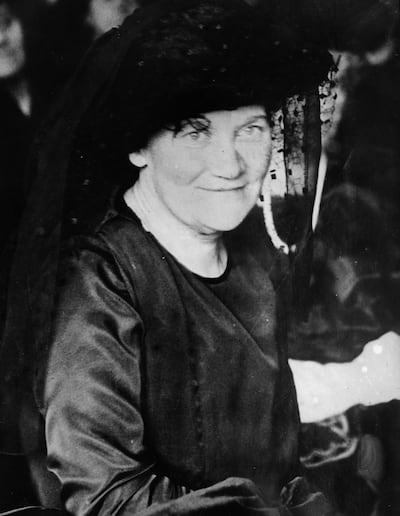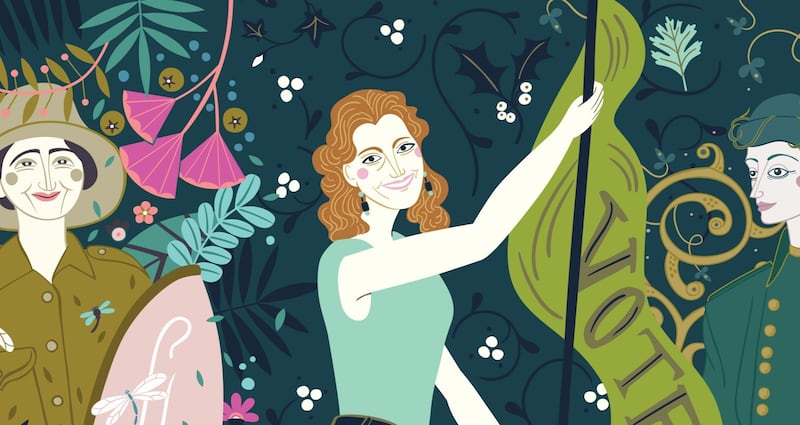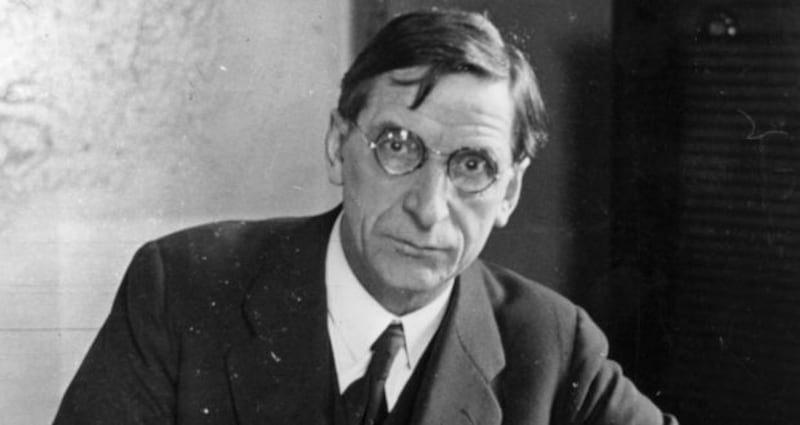In December 1918, two women, Countess Constance Markievicz and Winifred Carney, ran for election on the island of Ireland and one, Markievicz, was elected. While this marked a significant milestone, what happened politically in the coming years was more important for the position of Irish women in the Irish Free State, and on into the Irish Republic.
Initially, there was a sense of hope. The promise of female franchise and equality for women had been included in the 1916 Proclamation, and again in the Democratic Programme for Movement 1919, which included the desire that the country be “ruled in accordance with the principles of Liberty, Equality, and Justice for all”.


In the local elections of 1920, 43 women were elected, while in the 1921 general election, five additional women TDs joined Markievicz in the second Dáil: Kathleen Clarke, Kate O'Callaghan, Margaret Pearse, Ada English and Mary MacSwiney. All were members of Sinn Féin.
Between then and the next election in July 1922, however, momentous events changed the political landscape for all in Ireland, but particularly for political and activist women.
The 1922 election was essentially a referendum on the Anglo-Irish Treaty, the agreement between the UK and Irish representatives that brought an end to the War of Independence, providing for the establishment of the Irish Free State and giving Northern Ireland the option to opt out, which it took.
All six women TDs had rejected the Treaty, along with Cumann na mBan, the first militant organisation to do so. The women TDs had also argued that all women over the age of 21 should be given the vote in advance of the 1922 election, on a par with men. Arthur Griffith and Michael Collins refused, claiming the electoral register could not be updated in time, but the suspicion was they feared the vote of young women would be mostly anti-Treaty. This was not the last time suspicions of politicised women would form a part of the Irish Free State political discourse.
The June 1922 election was therefore conducted without the votes of women under the age of 30. The people voted in favour of the Treaty, and four of the anti-Treaty women TDs lost their seats, while the two returned, Kate O’Callaghan and Mary MacSwiney, refused to take theirs in the third Dáil.
As Civil War came and went, and as Irish politics became further divided, the position of women in the new Irish Free State became extremely contested. In the 1923 election for the fourth Dáil, young women between the age of 20 and 30 were now included in the franchise, and this is reflected in the election of five women TDs: Caitlín Brugha, Kathleen Lynn, Mary MacSwiney, Constance Markievicz and Margaret Collins O'Driscoll.
But Brugha, Lynn, MacSwiney and Markievicz were all Sinn Féin abstentionists and did not take their seats, while Collins O’Driscoll, a member of Cumann na nGaedheal, always voted to party line, even when that vote was against women’s rights. The absence of women politicians who would fight for women’s rights in the Dáil impacted on the ability of women to resist the regressive, anti-women policies of the Irish Free State from the beginning.
There were four women senators – Jennie Wyse Power, Eileen Costello, Kathleen Clarke, and Kathleen Browne, who campaigned for women's rights, but their impact was limited.

Equal rights
The 1922 Constitution had granted all citizens religious and civil liberty, equal rights and equal opportunities, regardless of their gender. But despite these promises of equality, for the State and the Church, the model of acceptable Irishwomen was the respectable, married, reproductive woman, not the unmanageable revolutionaries who had fought with Cumann na mBan, or the feminists who campaigned for women's rights in various women's organisations. Irish women's citizenship was, according to the increasingly conservative Free State, and the increasingly powerful and influential Catholic Church, domestic, to be defined by life in the home, marriage and motherhood.
Between 1922 and 1932, the Cumann na nGaedheal government passed a series of measures which chipped away at women’s rights, and promoted the discourse of women in the home. The right to sit on juries, the right to work in certain areas of the civil service, and the introduction of the marriage bar impacted on the ability of women to participate in politics or work outside the home.
Laws censoring information about contraceptives, and then outlawing access to them altogether, thereby impacting women’s right to control their own fertility, were enacted.
A new Fianna Fáil government led by Éamon de Valera came to power in 1932, but women hoping for change would only be disappointed. Long-time feminist campaigner Hanna Sheehy-Skeffington said she had "no belief" in de Valera, who was "well meaning, of course, better than Cosgrave, but really essentially conservative and church-bound, anti-feminist, bourgeois and the rest".
Fianna Fáil continued the anti-women polices of Cumann na nGaedheal, enacting legislation which further defined women’s place as in the home, culminating in the 1937 Constitution. In 1935, the government introduced the Criminal Law (Amendment) Act, section 17 of which imposed a complete ban on the importation and sale of artificial contraceptives.
In 1936, the Conditions of Employment Act extended the marriage bar of the Civil Service Amendment Act to the entire civil service, and gave the minister for labour the power to restrict the employment of women workers in any industry.
As government legislated to enforce women’s domestic role, the Church also defined women as belonging in the home. For the Church, the woman in the home was a moral cornerstone of the new State. The moral purity of Irish women was essential for the well-being of the Irish family, the Church believed, which led to a stringent regulation of female sexuality through most of the 20th century.
As a writer in the Irish Monthly noted in 1925, "women had but one vocation, the one for which nature had admirably suited her . . . that of wife and mother. The woman's duties in this regard, especially that of bringing up children, are of such far-reaching importance for the nation and the race, that the need of safeguarding them must outweigh almost every other consideration".
This Church and State doctrine on the position of women prevailed through the 1930s, despite resistance from women politicians and activists. While the female TDs did not argue against anti-women legislation, those in the Senate did. Time and again they argued against these pieces of legislation, often harking back to the promises of equality in the Proclamation and reiterated in the 1922 Constitution.
Senator Eileen Costello, in opposing the 1925 Civil Service Regulation (Amendment) Bill, which curtained women right take some competitive civil service exams and thereby blocking them from promotion, said “women were still to be subject to the obligations of citizenship, but their privileges were to be curtailed and restricted”. This, she felt, was absolutely against the spirit of equality written into the 1922 Constitution.

Senator Kathleen Clarke, in her arguments against the 1936 Conditions of Employment Act, which restricted the employment of women workers, said: “[The] Proclamation gave to every citizen equal rights and equal opportunities . . . if you legislate against one section of the community . . . where are the equal opportunities provided for in that proclamation?”
Anti-women legislation
It was not just mainstream political women who campaigned against anti-women legislation, and the conservative nature of the State. In the first two decades of the Free State, organisations such as the Irish Women's Citizens Association, National University Women Graduates' Association, Women's Citizens and Local Government Association, Joint Committee of Women's Societies and Social Workers, the National Council of Women of Ireland, and the Irish Women Workers Union (IWWU) resisted the anti-women policies of the State, while long-time feminist activists like Hanna Sheehy-Skeffington, Mary Kettle, Margaret Skinnider, Kathleen Lynn, Louie Bennett, Helena Molony and Jinny Shanahan were among many who, as historian Caitríona Beaumont has written, were "unwilling to accept the erosion of any of their citizenship rights".
For working women, pay and conditions, as well as access to the workplace, continued to be problematic. In this, they were often abandoned by male trade union comrades. In 1935, the Conditions of Employment Act, which proposed to restrict where women could work, was supported by male Labour and trade union leaders. Many female activists, like trade union member and former rebel Helena Molony, expressed their disgust that Labour leaders were supporting a "capitalist minister in setting up a barrier against one set of citizens".
The IWWU held a meeting at the Mansion House in November 1935 where it was noted that the Bill would create poverty by piling the miseries of unemployment on women. The Bill passed despite all this opposition.
By 1937, the Irish Women’s Citizens’ Association noted the position of women within the Irish State had deteriorated from the ideal implicit in the Proclamation. There was further resistance from feminists when the draft of the 1937 Constitution was published. Many were furious at its articles on women, including the references to women in the home, and the proposed restrictions on her working rights.
The Association of Old Cumann na mBan wondered about “the inadequate strength of women” – a line included in the draft – when women had moved “heavy muscular toil conveying machine guns, heavy explosives and rifles”, during the War of Independence.
‘Permanent inferiority’
For Hanna Sheehy-Skeffington, the Constitution was “a Fascist Model”, which would regulate women to “permanent inferiority”, while the IWWU insisted that Article 40.1 (women in the home) tended “to place women in a different category of citizenship from men and in a different position from men”.
But the ideal Irishwoman, respectable, married, domestic, a women who knew and accepted her place in society, was a powerful model which, as historian Maryann Valiulis has noted, "served the interests of the ruling male elite", aiding political and ecclesiastical leaders to "re-establish gender boundaries and hierarchy after the promise of equality and the experience of freedom of the revolutionary period".
Despite these objections from feminists, the 1937 Constitution was carried by popular vote. The social conservatism of the 1920s and 1930s found full force in the legislative actions against the female worker, and in the Constitutional definitions of women’s life as within the home; this gendered ideology which was to affect the lives of women and the position of the female worker in Ireland, legally and ideologically, until late into the 20th century.
Some aspects of that gendered ideology still impact on women’s lives in Ireland today. For instance, the gender pay gap is in large part a result of the marriage bar, while the necessity of gender quotas in politics and academia is, in part, a legacy of the anti-woman worker legislation passed in the first decades of the Irish Free State.
Irish women continued to deal with the impact of anti-women ideologies which underpinned the formation of the Irish State on into the 21st century. Access to contraceptives and full reproductive rights were issues only finally resolved from the 1990s, while the 2018 success of the Repeal the Eighth campaign demonstrated widespread acceptance that people could control their own reproductive bodies.
But there are issues still outstanding. Article 40.1 (women in the home) remains in the Constitution. In a modern state, is it the place of the Constitution to define the position of women as in the home, when equality campaigns have successfully argued for agency and choice for women? An upcoming referendum on this Article will hopefully see it repealed and removed from the Constitution, another cornerstone of the sexist ideology which dominated Irish politics and society for far too long.










